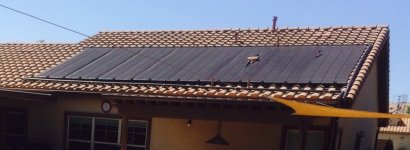- Jul 23, 2021
- 32
- Pool Size
- 16000
- Surface
- Vinyl
- Chlorine
- Salt Water Generator
- SWG Type
- CircuPool Edge-40
Couple pics of the setup:
Far panel is the first in the series, near panel is the second in the series and should send water back to the pool from the bottom/outlet port. All inlets/outlets are in the middle of this setup.

Plumbing (In = check valve --> diverter valve --> isolation valve --> far panel inlet --> outlet of far panel to inlet of near panel, on top --> outlet of near panel is at the bottom --> Return is isolation valve --> diverter T --> check valve)



So I have these side by side, as putting them on top of one another was a bigger challenge than I wanted to tackle.
What I'm seeing, though, is that using my IR temp gun, I believe the input water is basically going right to the output side on the far panel (essentially my "first" panel in the series), to the top/inlet of the second panel). Temp at the first panel input is about 55*, which is about what the pool water is right now. At the OUTPUT of the first panel it's much higher, about 75*, but at the INPUT of the second/near panel, it's back at like 58*. It's a very short path from the output of the first to the input of the second so if the water was flowing as I desired, it should be about the same, but it's not.
I've tried messing with the middle valves in each panel to direct the flow a bit and while I have seen some success, the numbers just aren't matching up to my expectation, that the water would fill panel 1, then flow to the top of 2, and out the bottom of 2.
Hopefully this makes a little sense. I think my options are to try and come up with a way to mount these vertically and use Fafco's recommended plumbing diagram that they sent me, or, run them parallel with T's.
Any thoughts or suggestions are appreciated. I have them running now since this is our first year and I'm trying to learn how they work and how to optimize them before the swimming season really kicks off.
Thank you! If I can provide any further clarification, I will do my best.
Todd
Far panel is the first in the series, near panel is the second in the series and should send water back to the pool from the bottom/outlet port. All inlets/outlets are in the middle of this setup.

Plumbing (In = check valve --> diverter valve --> isolation valve --> far panel inlet --> outlet of far panel to inlet of near panel, on top --> outlet of near panel is at the bottom --> Return is isolation valve --> diverter T --> check valve)



So I have these side by side, as putting them on top of one another was a bigger challenge than I wanted to tackle.
What I'm seeing, though, is that using my IR temp gun, I believe the input water is basically going right to the output side on the far panel (essentially my "first" panel in the series), to the top/inlet of the second panel). Temp at the first panel input is about 55*, which is about what the pool water is right now. At the OUTPUT of the first panel it's much higher, about 75*, but at the INPUT of the second/near panel, it's back at like 58*. It's a very short path from the output of the first to the input of the second so if the water was flowing as I desired, it should be about the same, but it's not.
I've tried messing with the middle valves in each panel to direct the flow a bit and while I have seen some success, the numbers just aren't matching up to my expectation, that the water would fill panel 1, then flow to the top of 2, and out the bottom of 2.
Hopefully this makes a little sense. I think my options are to try and come up with a way to mount these vertically and use Fafco's recommended plumbing diagram that they sent me, or, run them parallel with T's.
Any thoughts or suggestions are appreciated. I have them running now since this is our first year and I'm trying to learn how they work and how to optimize them before the swimming season really kicks off.
Thank you! If I can provide any further clarification, I will do my best.
Todd







